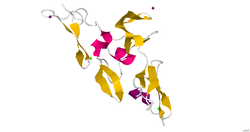Top Qs
Timeline
Chat
Perspective
Fibrillin
Protein family From Wikipedia, the free encyclopedia
Remove ads
Fibrillin is a glycoprotein, which is essential for the formation of elastic fibers found in connective tissue.[2] Fibrillin is secreted into the extracellular matrix by fibroblasts and becomes incorporated into the insoluble microfibrils, which appear to provide a scaffold for deposition of elastin.[3]
Remove ads
Clinical aspects
Marfan syndrome is a genetic disorder of the connective tissue caused by defected FBN1 gene. Mutations in FBN1 and FBN2 are also sometimes associated with adolescent idiopathic scoliosis.[4]
Types
Summarize
Perspective
Fibrillin-1
Fibrillin-1 is a major component of the microfibrils that form a sheath surrounding the amorphous elastin. It is believed that the microfibrils are composed of end-to-end polymers of fibrillin. To date, 3 forms of fibrillin have been described. The fibrillin-1 protein was isolated by Engvall in 1986,[5] and mutations in the FBN1 gene cause Marfan syndrome.[6][7]
This protein is found in humans, and its gene is found on chromosome 15. At present more than 1500 different mutations have been described.[1][7]
Structure
There is no complete, high-resolution structure of fibrillin-1. Instead, short fragments have been produced recombinantly and their structures solved by X-ray crystallography or using NMR spectroscopy. A recent example is the structure of the fibrillin-1 hybrid2 domain, in context of its flanking calcium binding epidermal growth factor domains, which was determined using X-ray crystallography to a resolution of 1.8 Å.[1] The microfibrils that are made up of fibrillin protein are responsible for different cell-matrix interactions in the human body.
Fibrillin-2
Fibrillin-2 was isolated in 1994 by Zhang[8] and is thought to play a role in early elastogenesis. Mutations in the fibrillin-2 gene have been linked to Beals syndrome.
Fibrillin-3
More recently, fibrillin-3 was described and is believed to be located mainly in the brain.[9] Along with the brain, fibrillin-3 has been localized in the gonads and ovaries of field mice.
Fibrillin-4
Fibrillin-4 was first discovered in zebrafish, and has a sequence similar to fibrillin-2.[10]
Remove ads
References
External links
Wikiwand - on
Seamless Wikipedia browsing. On steroids.
Remove ads

